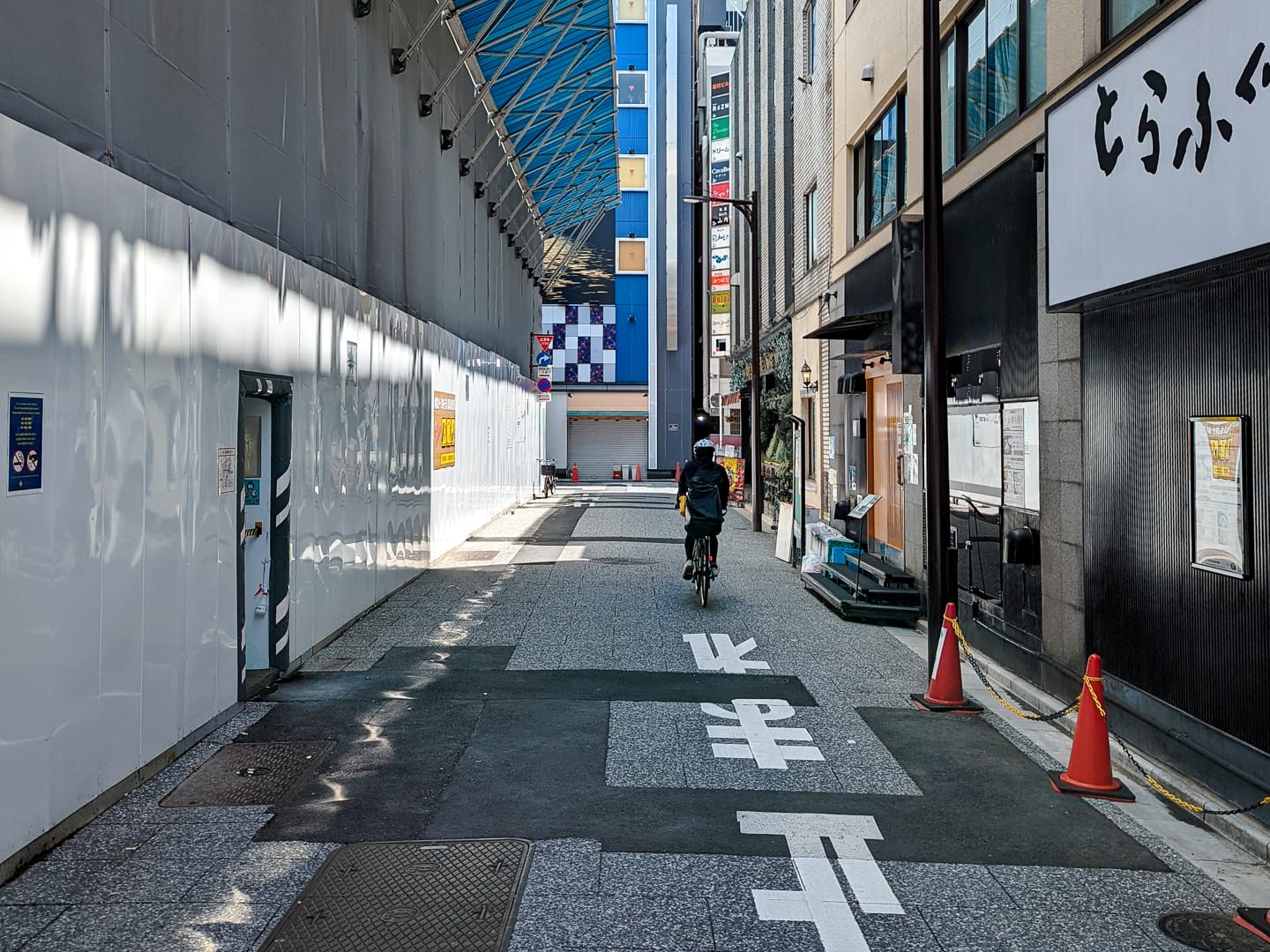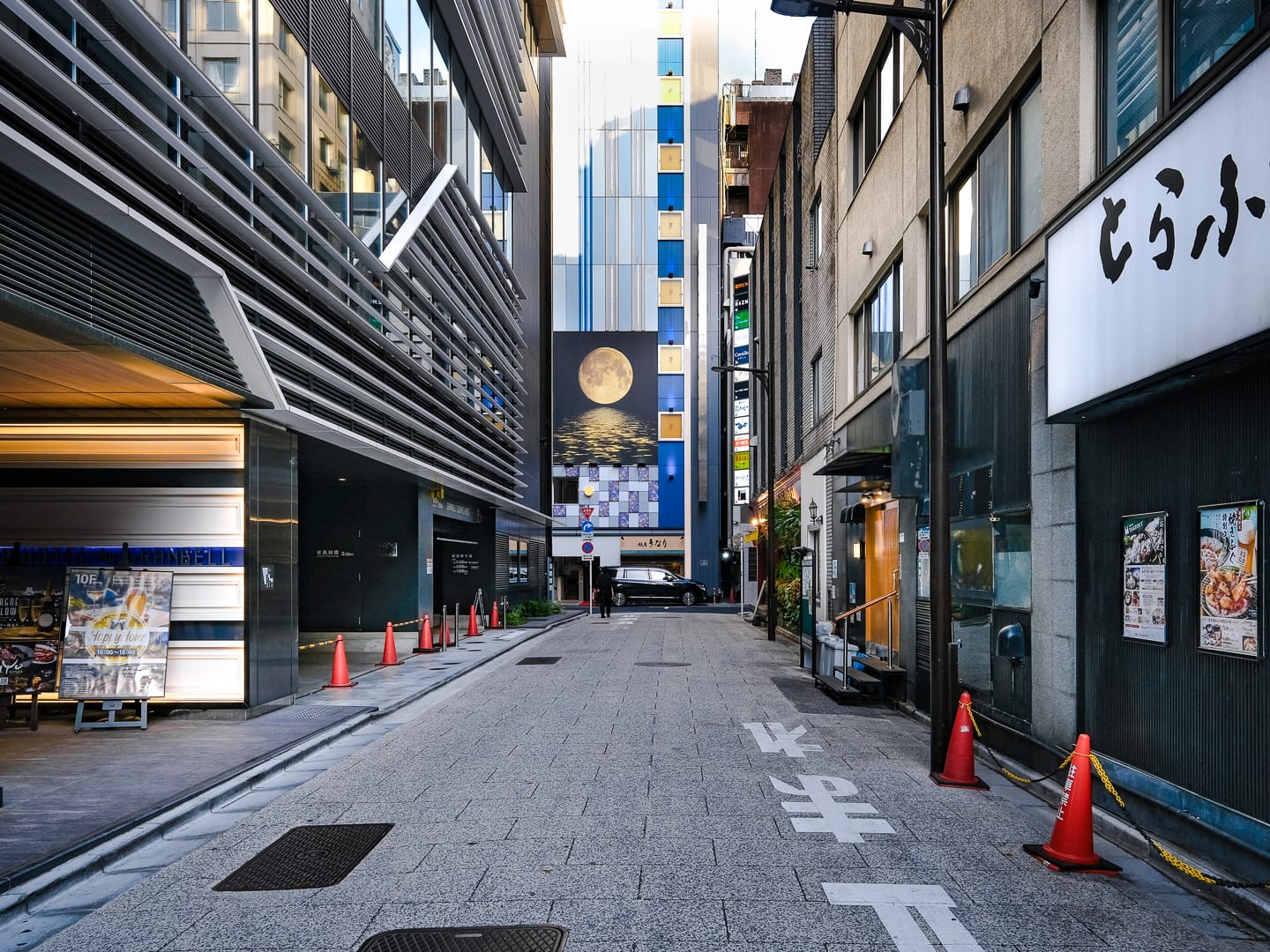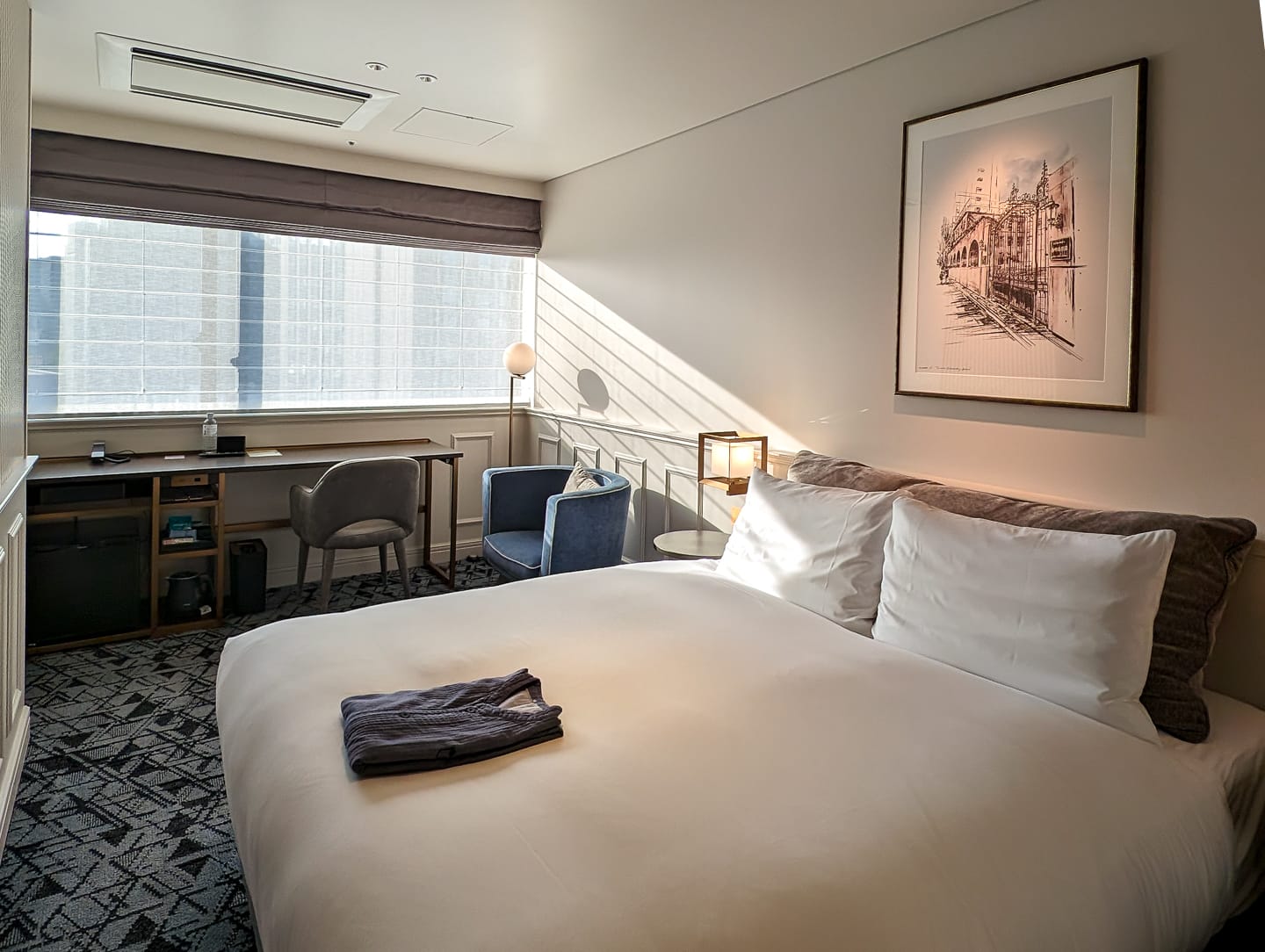
During a visit to Japan in the spring of 2022, I captured the above photograph and composed the accompanying caption:
A cyclist manoeuvres through a side street off Ginza Corridor, a lengthy under-track passage on the western perimeter of Ginza lined with bars, cafés, and restaurants that share an expressway for a roof. There is much to say about Ginza Corridor. Still, this side street leads away into the elongated 7-Chōme portion of Ginza, which reaches southeast toward the Sumida River, almost reaching Tsukijishijō Station, near the old site of Tsukiji Fish Market.
On the left of our cyclist, a hotel is under construction, a project featuring ten floors and three underground levels of hotel rooms and dining venues. Yellow signs caution passers-by to distance themselves from the site should an earthquake occur. Opposite, a fugu restaurant offers various preparations of the notoriously dangerous puffer fish delicacy alongside a Spanish restaurant located on the ground floor of the Kikamura Building. This zakkyo (mixed-use residence) houses various snack bars, small eateries, and specialist drinking establishments. At the street's end, the blue-panelled Gekkō (Moonlight) Building continues the trend, lighting up the alley at night in a kitsch yet faithful Ginza-esque style.
I wrote this long before publishing my writings about Tokyo in earnest, but last week, I unwittingly booked into the hotel mentioned, only realising upon arrival. The once boarded-up area on the left-hand side of the alley entering Ginza 7-Chōme has transformed into the newly opened Ginza Hotel by Granbell, further expanding Tokyo's vast hotel infrastructure. Below is the current street scene:

In anticipation of the Tokyo 2020 Summer Olympics, the city saw the opening of numerous new hotels, rationalised by the expected spike in room demand and the broader trajectory of rising inbound tourism. Unfortunately, the roughly 32,000 new rooms that swelled Tokyo's hotel capacity struggled with occupancy rates below 50%. The COVID-19 pandemic had compelled Japan to seal its borders, curb domestic travel, and delay the Olympics to 2021, where they proceeded surreally under the unchanged 2020 branding. Consider the implications of spending billions of yen on event signage, visuals, marketing materials, and merchandise only to have the date rendered obsolete.
Furthermore, imagine 32,000 brand-new, vacant hotel rooms. In response, the Japanese government intervened, offering a lifeline through subsidies and loans to aid the survival of hotels, particularly benefiting smaller operators lacking the financial buffers of their larger counterparts. Despite the challenges, Tokyo's hotel industry persevered and even redoubled its efforts: older establishments were refurbished, and certain chains, such as Granbell, boldly continued to expand, exemplified by the new Ginza Granbell. Investing in such a precarious future requires mettle, yet for Granbell, it is yielding dividends, as evidenced by its notably high occupancy during my stay last week.
This hotel boasts a neatly designed layout with contemporary interior styling, elevating it above competitors such as Sotetsu Fresa Inn and Dormy Inn. Its freshness resembles the more upscale Mitsui Garden Hotels, yet it is more reasonably priced. Its address, Ginza 7-2-18, is so new that it fails to register on Tokyo taxis' satnav systems. It requires guests to initially head to 2-17 and then collaborate with their taxi driver to locate the building. Previously, I had been to a Granbell hotel in Gion, Kyoto, which is notable for its exceptionally well-appointed reception; a similar aesthetic graces the Ginza Granbell, whose reception area extends to a terrace surrounded by Ginza's towering structures. Mirroring the Kyoto establishment, the property also includes a public sento bath.
The room I occupied was a marginally larger than usual double, designed with a clear priority for floor space at the expense of amenities: it lacked a closet, and the bathroom was restrictively small, equipped solely with a shower and devoid of any counter space. Conversely, the room featured a broad desk suitable for work, expansive windows that bathed the interior in daylight, and ample space for luggage, all contributing to a less claustrophobic experience than typically found in Tokyo hotel rooms. Such compromises are inevitable when navigating a Tokyo hotel's delicate interplay of cost, quality, and space.

A 15-minute walk across Ginza from the Granbell, the Sotetsu Fresa Inn Ginza 3-Chōme offers a more spacious classic Japanese combination bathroom yet maintains a stark ambience throughout the property that fails to enhance the overall guest experience. Meanwhile, chains like Dormy Inn deliver comparable locations at the lowest prices but confine you to rooms that epitomise the extremes of compact design. I find such rooms, typically under 15 square metres, to become stifling after just a few nights. For a more harmonious blend of comfort and location, the Mitsui Garden Hotel Ginza 5-Chōme is an option, albeit at a higher cost.
Alternatively, you might bypass Ginza for quieter, less connected areas such as Hatchōbori to the east or Kyōbashi to the north. This rationale holds when staying near any significant urban centre like Shinjuku or Shibuya: stepping just beyond the borders can broaden your options, though at the cost of reduced convenience and increased travel time as you move further out. Globally, each location presents unique challenges within its hotel scene; unless your budget is generous, the paramount issue is limited space in Tokyo. Personal tolerance levels vary, but typically, my strategy is:
1–3 nights: prioritise location, accepting confined quarters.
4-7 nights: find a balance between space and location, with a slight increase in nightly rates.
8 nights or more: give preference to spacious accommodations, even if it means staying further from the centre.
Staying further from the centre offers distinct benefits, particularly for those revisiting Tokyo—each neighbourhood has its merits, potentially leading to unique experiences in places you might otherwise overlook. However, this week featured a five-night sojourn at the Ginza Hotel by Granbell, located in Ginza 7-Chōme. My days consistently started and concluded on this block. Next, I'll highlight a few additional points of interest in the vicinity.
This is a members-only post
Join now to finish reading and access the full Tokyothèque archive.
